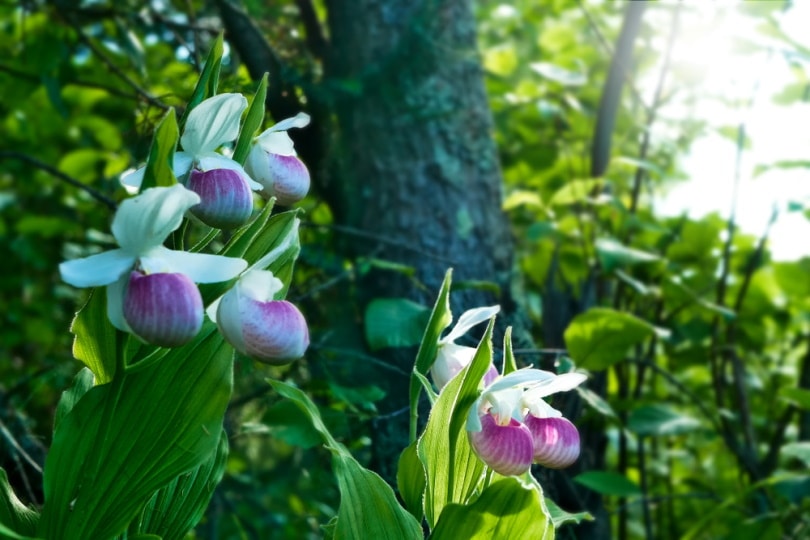What Is the State Flower of Minnesota? History & Reasons
-
Chris Dinesen Rogers
- Last updated:

States often single out different species or items that bring home a sense of place for an area. After all, what could be more iconic than Georgia’s state fruit, the peach, or Kentucky’s state horse, the Thoroughbred? Minnesota jumped on this bandwagon about the same time everyone else did around 1893. It bestowed the honor of the state flower to the Yellow Lady’s Slipper (Cypripedium calceolus).
Or did it?
The History of State Flowers
To get to the root of this botanical tale, we have to go back to the 1893 Chicago World’s Fair or the World’s Columbian Exposition. These events showcased the latest and the greatest on a global stage with much pomp and fanfare. This year was no exception. However, it was also the year that the Board of Lady Managers contributed to the arrangements.
This group suggested that each state should select a representative bloom for its “National Garland of Flowers.” After the world fair, it became the mission of women’s clubs across the nation to make it official.
You’d think that flowers could hardly stir heated emotions. Nothing about a vase filled with lovely-scented carnations certainly won’t cause an uproar. Unfortunately, it did, as Minnesota State Senator W. B. Dean and the Congress soon found out to their chagrin.

A Floral Controversy
Senator Dean was swayed by the excitement and grandeur of the Chicago World Fair when he sponsored a bill naming the Yellow Lady’s Slipper as Minnesota’s state flower and representative at the gala event. Unbeknownst to him, his floral resolution would become a stinky cause célèbre.
The senator had worked with a group of other legislators to select a fitting bloom. Other species considered included the Pond Lily, Cornflower, and Wild Rose, but the Yellow Lady’s Slipper won the vote. It became official on February 4, 1893. Sadly, it wasn’t a popular choice even from the start. The then Minneapolis Tribune blasted the pick, imploring the State Legislature to reconsider. Unfortunately, that isn’t the end of the story or the controversy.
Fast forward to February 1902. The members of the Saint Anthony Study Circle of Minneapolis made a startling revelation. The Yellow Lady’s Slipper isn’t native to Minnesota at all. It is a transplant from Eurasia, hence, its other common name, the European Yellow Lady’s Slipper. It is native in Europe to northern Japan and Algeria and doesn’t even appear on a list of Minnesota’s native plants.
The Minneapolis Tribune ran a story about the discovery, calling the Yellow Lady’s Slipper a fake. The State Legislature acted quickly to remedy their botanical blunder. On February 19, 1902, they named the Pink and White Lady Slipper (Cypripedium reginae) the official state flower. But, wait! There’s more.
The official designation didn’t happen until 1967 when Governor Harold LeVander signed it into law. Then, there’s the matter of its name. It’s not unusual for plants—or any organism—to have multiple names. That’s why you’ll see this flower called the Queen’s Lady Slipper, Showy Lady’s Slipper, or Large White Lady’s Slipper. Take your pick!
Perhaps to further correct its errors, the State Legislature enacted legal protections against collecting, selling, or buying the state flower or any orchid. Minnesota clarified the law in 1984 in no uncertain terms. Of course, the flower doesn’t make transplanting them easy anyway. That’s part of what makes them so rare.

The Pink and White Lady’s Slipper
You might think that all orchids are tropical. While some are beach bunnies, the Pink and White Lady’s Slipper’s ideal habitat bucks that notion. You’ll find this flower in the eastern half of the United States in New England and Canada. It lives in wetland habitats, such as fens and bogs. It prefers well-draining soils. The plant gets up to 27 inches tall. It is surprisingly long-lived if not disturbed.
Its unusual and irregularly shaped flowers resemble a slipper, thus, its iconic name. The Pink and White Lady’s Slipper blooms from June to July, with bees and other insects acting as pollinators. The plant grows in 33 of the state’s 87 counties. While the population isn’t endangered in Minnesota, officials have classified it as critically imperiled in Iowa, Illinois, North Dakota, and Nova Scotia.
The flower faces the same threats many species encounter, such as habitat encroachment, soil erosion, and surface runoff. However, the legislators in 1925 were ahead of their time. Orchid poaching is a serious problem in Minnesota and other places where it grows. The plant grows so slowly that even removing a few specimens can have long-term impacts on its survival.
Final Thoughts
The story of the Pink and White Lady’s Slipper and its designation as Minnesota’s state flower is a cautionary tale. Be sure to check your identification before you place such a high honor on any state symbol. Hopefully, conservation efforts and the sound judgment of individuals searching for this bloom will ensure that many more generations can enjoy it.
See also:
- 5 Dryer Sheets Alternatives (That Actually Work)
- How To Use Laundry Detergent Pods (Types & Advantages)
- https://www.startribune.com/minnesota-moment-the-wrong-state-flower/
- https://plants.ces.ncsu.edu/plants/cypripedium-calceolus/
- https://wcsp.science.kew.org/namedetail.do?name_id=53948
- https://webapps15.dnr.state.mn.us/mntaxa/reports/index
- https://explorer.natureserve.org/Taxon/ELEMENT_GLOBAL.2.159904/Cypripedium_reginae
Featured Image Credit: Edgar Lee Espe, Shutterstock
Contents
